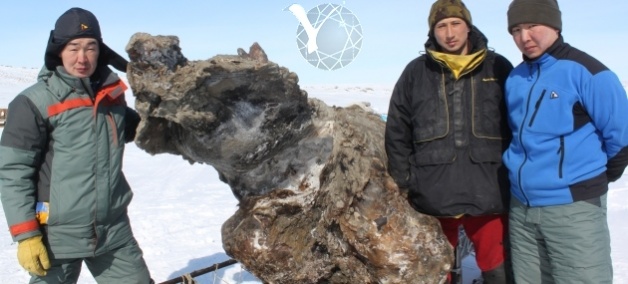
- 29 May 2013
- 89172
Sensational discovery: NEFU scientists have discovered a female mammoth
On 22 May, members of paleontological expedition of the Research Institute of Applied Ecology of the North, North-Eastern Federal University, and the Russian Geographical Society returned to Yakutsk. As a result, they found the carcass of a female mammoth in good preservation on Lyakhovsky Islands of Novosibirsk archipelago.
The mammoth soft tissues are well preserved. According to the scientists, the tissues of the animal are almost ideal, only the upper part of the body, head and left hind leg were skeletonized. The scientists examined the teeth and established that the mammoth’s age was about 50-60 years.
“The fragments of muscle tissues, which we’ve found out of the body, have a natural red color of fresh meat. The reason for such preservation is that the lower part of the body was underlying in pure ice, and the upper part was found in the middle of tundra. We found a trunk separately from the body, which is the worst-preserved part, said Semyon Grigoriev, the head of the expedition, the chairman of the Mammoth Museum named after P.A. Lazarev of NEFU Institute of Applied Ecology of the North. The researchers collected the samples of the animal’s blood in tubes with a special preservative agent. The blood is very dark, it was found in ice cavities bellow the belly and when we broke these cavities with a poll pick, the blood came running out. Interestingly, the temperature at the time of excavation was -7 to – 10ºC. It may be assumed that the blood of mammoths had some cryoprotective properties”.
A visit of the Russian and foreign colleagues is expected in July, who shown a keen interest in the new discovery. The mammoth samples were arrived in Yakutsk for bacterial examination in order to detect causative agents of especially dangerous infections.
“It was important to discover the mammoth in cold weather, because the unique discovery would melt in summer or autumn, and the priceless material for joint project “Mammoth rebirth” of NEFU and Sooam foundation could disappear from thawing and wild animals”, said Semyon Grigoriev.
NEFU RIAEN scientists dedicated their unique discovery to the 100th anniversary of Yakutsk branch of the Russian Geographical Society, one of the expedition organizers, and 20th anniversary of the Institute of Applied Ecology of the North.


 English
English Russian
Russian Chinese
Chinese